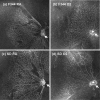Gene expression microarray analysis of early oxygen-induced retinopathy in the rat
- PMID: 20157446
- PMCID: PMC2821581
- DOI: 10.1007/s12177-009-9041-7
Gene expression microarray analysis of early oxygen-induced retinopathy in the rat
Abstract
Different inbred strains of rat differ in their susceptibility to oxygen-induced retinopathy (OIR), an animal model of human retinopathy of prematurity. We examined gene expression in Sprague-Dawley (susceptible) and Fischer 344 (resistant) neonatal rats after 3 days exposure to cyclic hyperoxia or room air, using Affymetrix rat Genearrays. False discovery rate analysis was used to identify differentially regulated genes. Such genes were then ranked by fold change and submitted to the online database, DAVID. The Sprague-Dawley list returned the term "response to hypoxia," absent from the Fischer 344 output. Manual analysis indicated that many genes known to be upregulated by hypoxia-inducible factor-1alpha were downregulated by cyclic hyperoxia. Quantitative real-time RT-PCR analysis of Egln3, Bnip3, Slc16a3, and Hk2 confirmed the microarray results. We conclude that combined methodologies are required for adequate dissection of the pathophysiology of strain susceptibility to OIR in the rat. ELECTRONIC SUPPLEMENTARY MATERIAL: The online version of this article (doi:10.1007/s12177-009-9041-7) contains supplementary material, which is available to authorized users.
Figures


Similar articles
-
Stability of small non-coding RNA reference gene expression in the rat retina during exposure to cyclic hyperoxia.Mol Vis. 2013;19:501-8. Epub 2013 Feb 25. Mol Vis. 2013. PMID: 23441123 Free PMC article.
-
Kinetics of strain-dependent differential gene expression in oxygen-induced retinopathy in the rat.Exp Eye Res. 2007 Oct;85(4):508-17. doi: 10.1016/j.exer.2007.07.001. Epub 2007 Jul 10. Exp Eye Res. 2007. PMID: 17692314
-
Stability of housekeeping gene expression in the rat retina during exposure to cyclic hyperoxia.Mol Vis. 2007 Aug 29;13:1508-15. Mol Vis. 2007. PMID: 17893650
-
Strain-dependent differences in oxygen-induced retinopathy in the inbred rat.Invest Ophthalmol Vis Sci. 2005 Apr;46(4):1445-52. doi: 10.1167/iovs.04-0708. Invest Ophthalmol Vis Sci. 2005. PMID: 15790914
-
Hereditary influences in oxygen-induced retinopathy in the rat.Doc Ophthalmol. 2010 Feb;120(1):87-97. doi: 10.1007/s10633-009-9196-3. Epub 2009 Sep 19. Doc Ophthalmol. 2010. PMID: 19768476 Review.
Cited by
-
Next-generation sequencing analysis of gene regulation in the rat model of retinopathy of prematurity.Doc Ophthalmol. 2013 Aug;127(1):13-31. doi: 10.1007/s10633-013-9396-8. Epub 2013 Jun 18. Doc Ophthalmol. 2013. PMID: 23775346 Free PMC article.
-
Sex differences in corneal neovascularization in response to superficial corneal cautery in the rat.PLoS One. 2019 Sep 3;14(9):e0221566. doi: 10.1371/journal.pone.0221566. eCollection 2019. PLoS One. 2019. PMID: 31479468 Free PMC article.
-
Stability of small non-coding RNA reference gene expression in the rat retina during exposure to cyclic hyperoxia.Mol Vis. 2013;19:501-8. Epub 2013 Feb 25. Mol Vis. 2013. PMID: 23441123 Free PMC article.
-
Interconnections between apoptotic, autophagic and necrotic pathways: implications for cancer therapy development.J Cell Mol Med. 2013 Jan;17(1):12-29. doi: 10.1111/jcmm.12001. Epub 2013 Jan 10. J Cell Mol Med. 2013. PMID: 23301705 Free PMC article. Review.
-
Development of a Bioinformatics Framework for Identification and Validation of Genomic Biomarkers and Key Immunopathology Processes and Controllers in Infectious and Non-infectious Severe Inflammatory Response Syndrome.Front Immunol. 2020 Mar 31;11:380. doi: 10.3389/fimmu.2020.00380. eCollection 2020. Front Immunol. 2020. PMID: 32318053 Free PMC article.
References
-
- Palmer EA, Flynn JT, Hardy RJ, Phelps DL, Phillips CL, Schaffer DB, et al. Incidence and early course of retinopathy of prematurity. The Cryotherapy for Retinopathy of Prematurity Cooperative Group. Ophthalmology. 1991;98:1628–40. - PubMed
LinkOut - more resources
Full Text Sources
Molecular Biology Databases
